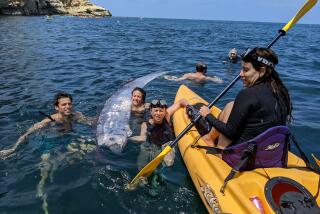After more than 20 years of study, scientists are ready to say what they found off Monterey’s coast

- Share via
Over two decades ago, researchers spotted a mysterious sea slug swimming more than 8,000 feet deep in the Monterey Bay.
In February 2000, scientists from the Monterey Bay Aquarium Research Institute were using a remotely operated vehicle to observe sea animals offshore when they discovered a bioluminescent mollusk with a large gelatinous hood and paddle-like tail.
The sea creature, which they nicknamed the “mystery mollusk” because of its snail-like features, captivated them. But it would be years until the general public learned of this deep-sea discovery.
Over the past 20 years, the team has used the institute’s underwater technology to gather more information on the sea slug. They named the creature Bathydevius caudactylus. Scientists have seen the animal 150 more times and just published their findings in the December 2024 edition of the journal Deep-Sea Research Part I.
A dead moray eel washed ashore near Laguna Niguel over the weekend, creeping out beachgoers.
“Thanks to [the research institute’s] advanced underwater technology, we were able to prepare the most comprehensive description of a deep-sea animal ever made,” Monterey Bay Aquarium Research Institute senior scientist Bruce Robison said in a news release. “We’ve invested more than 20 years in understanding the natural history of this fascinating species of nudibranch. Our discovery is a new piece of the puzzle that can help better understand the largest habitat on Earth.”
Robison was one of the leaders in the effort to describe the animal, which researchers initially had difficulty putting in a group. Eventually, they were able to more closely examine the animal in the lab and confirmed it was a nudribranch, also known as a sea slug, according to the release.
Nudibranches tend to live on the seafloor and in coastal environments, such as coral reefs, kelp forests and tide pools. The mystery mollusk is the first known nudibranch to live in a deep-water column, specifically in the ocean’s midnight zone — open water about 1,000 to 4,000 meters below the surface.
The creature lives offshore along the Pacific coast of North America and has been spotted as far north as Oregon and as far south as Southern California, according to the release. It uses a cavernous hood to trap crustaceans to eat — a feeding strategy also used by anemones and some jellies. To avoid being eaten, the mollusk hides with its transparent body and makes a quick escape by quickly closing its oral hood, similar to the movements of a jellyfish.
San Pedro High School discovered a deposit of marine fossils on campus in 2022 and began collaborating with local paleontologists to uncover secrets from the Palos Verdes Peninsula’s geological past.
The mollusk lights up using bioluminescence when threatened to distract predators, researchers said. Scientists have observed the creature using a “finger-like projection” from its tail as a decoy.
“When we first filmed it glowing ... everyone in the control room let out a loud ‘Oooooh!’ at the same time. We were all enchanted by the sight,” senior scientist Steven Haddock said in the release.
Haddock said the discovery highlights the importance of deep-sea exploration and the significance of using new technology to catalog previously unknown creatures.
“The more we learn about deep-sea communities, the better we will be at ocean decision-making and stewardship,” he said
More to Read
Sign up for Essential California
The most important California stories and recommendations in your inbox every morning.
You may occasionally receive promotional content from the Los Angeles Times.













